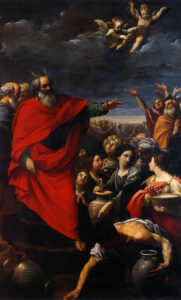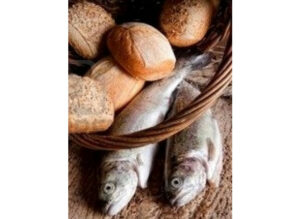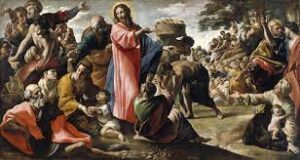
The Corporal Works of Mercy – Feeding the Hungry
The Works of Mercy recommended by the Church do not have priority over one another, but all are of equal importance
Many artists have endeavored to illustrate the beauty of the works of Mercy, considered individually or as an element that resulted in a miracle or extraordinary event. Feeding the hungry is a human need that God first wanted to remedy. In the Old Testament various episodes are recounted and one cannot fail to consider God’s merciful action toward his people.

Guido Reni (1572/1642) a painter from Bologna, worked at Ravenna Cathedral from 1614 to 1616 where he depicted the very episode of Moses and the gathering of the Manna: “At sunset you will eat meat, and in the morning you will be filled with bread; you will know that I am the Lord your God.” In the large painting Moses then, wrapped in his broad red cloak, flanked by Aaron, reports what God has communicated to him and raises his hand as if to initiate the miracle. While below, the Jews with their vessels prepare to collect the manna that two plump angels drop from a dark cloud, some raise their hands toward heaven. The large crowd that can be glimpsed in the depths has light and misty colors like the light that is rising in the distance and seems to chase away the dark night sky, to give comfort and reassure the spirits of all. And so for forty years they ate meat and bread that tasted like buns with honey-a wonderful response that, in his mercy, God gives to the insulting murmuring of his people.

Providing for the hungry people was, instead, a request Jesus makes to Philip when he sees the large crowd coming to Him. The apostle, naturally stunned, gives a normal response that says the impossibility of fulfilling his request, but Andrew ventures the absurd: “here is a boy who has five loaves and two fish …” It was about five thousand men. Jesus provides! John Lanfranco (1582/1647), elaborated on this Gospel passage and, in 1624/25, made it into a masterpiece that is now housed in the National Gallery of Ireland.

In his work, Jesus dominates the space by placing himself at the center of the depiction, just as we read in the Gospel; Christ is statuesque but dynamic, his arms outstretched and his hands holding bread, which he personally distributes. The apostles, astonished at the miracle performed, in turn distribute the bread and fish, while the surprised and excited crowd prepares to feed themselves. While a child in the foreground already opens his mouth wide to receive the bread from his mother, a young man sitting at Jesus’ feet turns to gaze in amazement at the Messiah. Also very significant is the attitude of the young man who, perhaps conversing with an apostle, points his index finger upward to indicate God’s merciful power. Here colors play a decisive role; in fact, the red of Christ’s mantle strikes the viewer who, while wandering with his gaze, is almost compelled to dwell again on the protagonist. Everything seems to magnify that moment, from the large basket overflowing with loaves, to the chromatic harmony given, through the morning light, to the trees, meadows, sky and clouds. Compassion moved God’s heart, overrode the natural disbelief of the apostles, who nevertheless immediately obeyed the unthinkable and organized the work to feed everyone.
The tradition of St. Anthony’s bread is linked to a miracle performed by the saint after the construction of the Basilica of Padua (1310). Girolamo Tessari is credited with the illustration of the miracle frescoed in 1524 in the audience hall of the basilica in Padua. The mother of a child who drowned due to her distraction asks St. Anthony to resurrect her son, promising to offer the poor as much bread as her son’s weight. The miracle takes place! The grace received leads the faithful from that moment, and still today, to have pity and mercy towards the needy and especially towards the poorest mothers, offering as much bread as the weight of their children.

Willem Van Herp, a Flemish painter (1614/1677), was commissioned in 1662 to paint this picture, now in the National Gallery in London, where the friars of the convent, according to the teachings of St. Anthony, receive and distribute bread to those who request it. Each character is portrayed in such a way as to highlight their most varied expressions, attitudes and attire, according to a perfect choice of juxtaposed and ringing colors that enhance the moment experienced by the faithful. Here God does not intervene directly, but performs the miracle through the intercession of St. Anthony who, surely shook the hearts of the people, faced with the poverty of the suffering.
Without discrimination, without regard to the rich or the poor, the healthy or the sick, this is the teaching that makes us grow in the exercise of charity. We are not being asked to do the impossible, the episodes that have been considered here should, however, make us reflect on world hunger, on the waste of so much food, and induce us to concretely do something for others, to have mercy on those who suffer, even today, from hunger.
Paola Carmen Salamino
